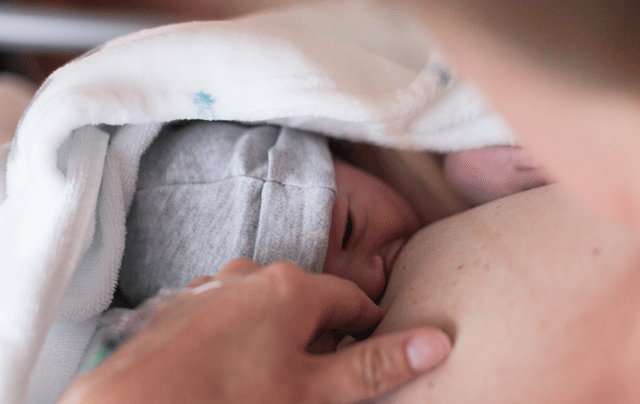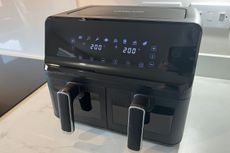Breastfeeding pain relief: Home remedies and ways to deal with discomfort
Breastfeeding pain is extremely common among new mothers. While it's usually nothing to worry about, don't ignore any symptoms or pain – especially if they persist for more than a couple of days.


Breastfeeding pain is extremely common among new mothers. While it's usually nothing to worry about, don't ignore the symptoms – especially if they persist for more than a couple of days.
What you shouldn't do is suffer in silence. Whether you're unsure about whether you're breastfeeding properly, what foods to eat or avoid during breastfeeding, or you're surprised by the unexpected aspects of breastfeeding, the early motherhood experience can only be bettered by good, tried-and-tested advice.
'There is an abundance of support available to mums during their breastfeeding journey,’ says Harriet Hickey, a midwife at The Pregnancy Clinic, which has clinics in Kent and Surrey. ‘It’s really important to remember that breastfeeding is a new skill for both you and your baby. Over time you will learn what works out best for you.’ These breastfeeding accessories can make the process more comfortable.
Here, our experts highlight the most common reasons for breastfeeding pain, and what the best breastfeeding pain relief home remedies are.
Breastfeeding pain: what causes it?
There are numerous reasons for breastfeeding pain – most of which are benign and easily treated.
'It’s very common for women to experience breastfeeding pain, especially first-time mothers,’ says Eleni Mavrides, a consultant in obstetrics and gynaecology. ‘It’s normal for your body to take a few days when first starting to breastfeed to adjust and in that time, you may feel discomfort or pain,’ she explains.
'This is usually because your breasts over-produce milk at the beginning,’ she continues. ‘You can help prevent this through massaging your breasts regularly, letting your baby finish their feeds, and making sure your baby is attaching to the breast properly during feeding. Using over-the-counter medication, such as paracetamol, will manage the pain if you're in need of pain relief.'
GoodtoKnow Newsletter
Parenting advice, hot topics, best buys and family finance tips delivered straight to your inbox.
Breastfeeding pain in the breast and home remedies to help
Breast engorgement
While breast engorgement is typical for new mums as they adjust to the arrival of milk, it can be very uncomfortable. ‘Breast engorgement happens when your breasts become overly full. This can be quite painful, with symptoms such as tight or hard breasts, pain in your armpit and sometimes difficulty in attaching baby to the breast,’ explains Harriet.
‘If breast engorgement happens in the first few days of your baby’s life this may be due to your baby simply establishing their feeds. If this is the case support with positioning and attachment can make all the difference,’ she says. ‘The symptoms of breast engorgement should settle once you gain further confidence in positioning and attachment.’
If your baby is yet to latch properly, try expressing some breast milk by hand. Avoid the use of nipple shields, though. 'They can restrict the amount of milk the baby is able to get, which can lead to the breasts becoming more engorged and sore,’ warns Daniel Brash, a pharmacist and co-director of Healthcare 4 All.
Then there’s the old wives’ tale of placing chilled cabbage leaves in your bra after feeding or expressing. While it seems a little eccentric the cooling effect on your breast really can help to reduce the pain and swelling. You can also wrap a towel around a small bag of frozen vegetables and place it on the swollen area to relieve swelling and numb the pain.
Wearing a well-fitting bra designed for breastfeeding, so it doesn’t restrict your breasts, could also benefit you.
Your midwife, health visitor or a breastfeeding specialist should also be able to help you deal with engorged breasts, or any other breastfeeding pain or concerns.

Mastitis
‘Mastitis can happen as a consequence of a blocked milk duct,’ says Harriet. ‘The breast becomes inflamed and often very painful,’ she says. This inflammation may quickly become an infection if not treated, which means that bacteria can grow in the milk.
Here, Harriet explains the main symptoms of mastitis:
- A noticeable red area on the breast
- Tender and hot-to-the-touch breast
- Flu like symptoms/generally feeling unwell
- High temperature
Often mastitis is a reaction to poor positioning, which – once rectified – can ease the problem. ‘However, if symptoms of mastitis are not relieved after you've checked your baby’s positioning and attachment, much like when relieving symptoms of breast engorgement, then it’s important to get checked out by your GP,’ advises Harriet.
Eleni agrees: 'If your breasts feel inflamed, red, hot, tender or lumpy, and you feel unwell with flu-like symptoms, such as fever, chills and tiredness, make sure you ask for help straight away.’ If left untreated mastitis can become a breast abscess.
If you’re not feeling better within 12-24 hours, or if you feel worse, see a doctor. You may need antibiotics, which will be fine to take while you are breastfeeding. To control the pain, over-the-counter medicines such as ‘paracetamol or ibuprofen may also help,’ she says.
It’s important to keep feeding your baby from the affected breast. Although this may be painful and miserable for you, it can make the mastitis worse if you stop feeding from your affected breast.
Breast abscess
‘When mastitis is untreated it can cause a breast abscess,’ warns Harriet. An abscess is a very painful, swollen, pus-filled lump inside the breast. You can also develop a breast abscess after a prolonged period of breast engorgement.
A breast abscess needs immediate treatment by a medical professional. The abscess may be drained, or you may be prescribed antibiotics. Although it seems counter-intuitive, it’s important to keep breastfeeding. This keeps the breast well-drained. If it’s too painful to breastfeed you can pump or express by hand instead. “If the affected breast is too painful or the incision is close to your nipple you may need to express your milk for a day or two. Keeping your milk flowing will help your breast heal,” recommends the La Leche League Great Britain website, which provides mother-to-mother support for breastfeeding mums.

Breastfeeding pain in the nipples and home remedies to help
Problems with latching
If your baby is poorly attached to your breast during a feed, your nipple may become pinched between your baby’s tongue and the roof of their mouth (the hard palate). This will make your nipples sore. Before long your nipples can crack and bleed, which makes breastfeeding uncomfortable and even painful. When your baby is effectively attached, your nipple rests comfortably against the soft palate at the back of their mouth. This makes a huge difference in comfort.
‘It’s really quite common to have issues with latching. As a result there’s a lot of help available,’ says Harriet. ‘Some important points to remember – especially when you are struggling with the latch – are:
- Being comfortable and making sure you are in a position you can sustain for some time i.e. utilising a comfy chair and cushions to support your arms and shoulders. Nursing cushions are really useful.
- Holding your baby close and ensuring you’re not leaning over to feed your baby.
- Ensuring your baby’s head and body are in a straight line, their chin to your breast with their head free to tilt backwards.
- Aiming to place your baby’s nose level to your nipple to encourage a wide-open mouth when attaching.’
As well as Harriet's advice, Eleni suggests that ‘mothers change the position of their baby frequently when breastfeeding. One position to try involves putting your baby tummy-down on your body with their head near your breast. This is also a great position to try and get your baby to self-latch as they bob their head and move towards the breast with minimal help from mum, usually resulting in a pain-free latch,’ she says.
Don’t keep trying on your own if it still hurts – find a lactation consultant or speak to your doctor, health visitor or midwife.
Tongue tie
If your baby is suffering from tongue tie, it can make latching onto your breast correctly impossible, which is distressing for both mum and baby. Tongue tie means your baby can’t lift its tongue or stick it out so is unable to cup the breast to extract milk. This can mean a lot of pain for mum as the tongue can rub against the end of nipple, causing it to crack.
‘Tongue tie occurs when the skin between your baby’s tongue and mouth are shorter than expected,’ says Harriet. ‘This can sometimes affect breastfeeding and should always be considered when there’s difficulty with attachment and latch,’ she advises.
Because tongue tie can be difficult to diagnose, it helps to get expert support. 'Ask your midwife or health visitor to check for tongue tie. Tongue tie is often picked up soon after birth but can be difficult to detect,' advises Daniel.
‘Your midwife, health visitor or GP will be able to guide you, with referral to an expert,’ says Harriet. A health professional will snip the thin flap of skin on the baby’s tongue so it’s able to move more freely. This quick and almost painless procedure will make breastfeeding more effective and less painful.

Blocked ducts
Ducts are another potential breast issue. ‘The breasts are made of milk-producing glands. Tubes known as milk ducts transport the milk from these glands to your nipple. This is so you're able to feed your baby,’ explains Harriet. ‘It’s not uncommon for these ducts to become blocked. They don’t always drain properly during a feed, particularly in those early days of establishing feeds,’ she says. These ducts can also become blocked if you’re making breast milk faster than you can express it.
If you have blocked ducts you're likely to feel ‘a small lump just under the breast, which can sometimes feel quite tender,’ says Harriet. Check under your breasts regularly – if you suspect a blocked duct Harriet recommends the following:
- ‘Feed your baby from the area where you can feel a blocked duct. Massage the lump gently towards the nipple at the same time.
- A warm bath, shower or flannel on the breast may relieve any discomfort.’
The La Leche League GB website also recommends “avoiding saturated fats and taking one or two 1200mg capsules of lecithin three or four times a day to reduce the risk of blocked ducts.”
Thrush
Most of us know thrush as a vaginal condition. However, it’s possible to get this yeast infection on our skin – especially warm, moist areas such as the armpits, groin, between the fingers and the breasts.
‘Some women develop thrush in their breasts when feeding. Symptoms include painful breastfeeding in both breasts, and pain which does not pass immediately following feeding,’ explains Harriet. The NHS website also says to look out for “a red, itchy or painful rash that scales over with white or yellow discharge. The rash may not be so obvious on darker skin.”
Even mild thrush needs checking. ‘It’s important to treat thrush, as it can be passed from mum to baby and vice versa.' You can learn more about breastfeeding and thrush here but it's also recommended that you speak to your GP if you think you have it. Thrush is treated with over-the-counter creams or prescribed anti-fungal medication for mums, and drops for babies.
Breastfeeding pain in the armpit and home remedies to help
Some mums will feel pain under the arms. ‘The breast tissue is present not only in breasts but also extends into the armpit,’ says Harriet.
‘It’s not unusual to have swelling and engorgement of a small area in the armpit while breastfeeding,’ she adds. ‘Engorgement is common as breastfeeding is being established. It usually goes away once feeding is established.’

Is breastfeeding pain normal?
It's easy, as a sleep-deprived new mum, to think the worst but breastfeeding pain is common. ‘There are a number of reasons why breastfeeding causes discomfort,' says Harriet. 'While quickly resolved, it’s important to understand why you’re in discomfort and to not ignore any pain.'
Top tips for soothing painful breasts when nursing
‘Breastfeeding pain is not uncommon,’ says Harriet reassuringly. ‘And discomfort can be prevented and treated.' This will allow for successful feeding until you're ready to stop breastfeeding.
The main thing is to speak up. ‘Seek advice from your midwife or a breastfeeding specialist – also called a lactation consultant. They can discuss simple measures to prevent breastfeeding pain. For example, ensuring there's proper latching when baby is feeding as the inability to do so leads to breast milk not draining properly, which causes sore nipples, lumps and engorged breasts,’ adds Harriet. If you grapple with dry nipples or breasts ‘use breastfeeding-friendly ointments to keep them moist,’ advises Harriet. We like Mama Mio’s Keep Calm Nipple Balm.
‘At times, a cold compress helps with soreness and pain from swollen breasts,’ advises Harriet. ‘It’s okay to use simple painkillers such as paracetamol to relieve pain.’
However, ‘if those measures don’t relieve symptoms seek advice from your doctor or midwife to rule out infection,’ she says.
Video of the Week:

Debra Waters is an experienced online editor and parenting writer. She also has a strong background on health, wellbeing, beauty, and food. She currently writes for Goodto and Woman&Home, and print publications Woman, Woman’s Own, and Woman’s Weekly. Debra has written for What to Expect, Everyday Health, and Time Out. In addition, she has had articles published in The Telegraph and The Big Issue.
-
 I tested the Lakeland Dual Basket air fryer and it made midweek family cooking a breeze
I tested the Lakeland Dual Basket air fryer and it made midweek family cooking a breezeYou can’t go wrong with the dual basket air fryer by Lakeland complete with easy-view windows to ensure burnt food is a thing of the past…
By Jessica Dady Published
-
 Reframing one simple habit could get your sex life back on track after having a baby, new research shows
Reframing one simple habit could get your sex life back on track after having a baby, new research showsMany parents struggle to get their sex life back on track after having a baby, but new research has shown how one simple habit could make all the difference.
By Ellie Hutchings Published